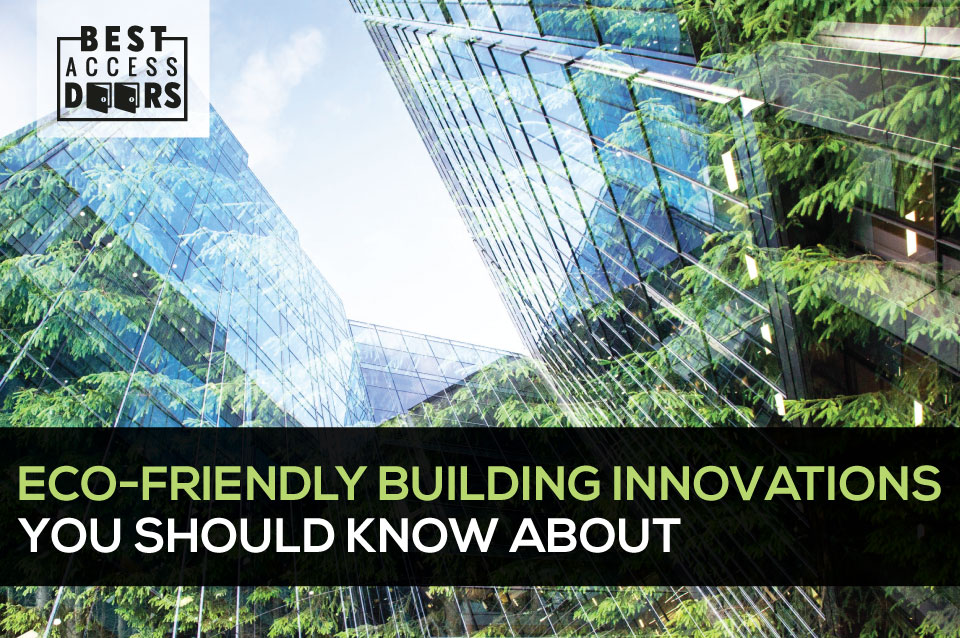Eco-Friendly Building Innovations You Should Know About
Posted by Best Access Doors on 21st Jul 2021
Eco-friendly buildings are also known as green buildings to achieve a sustainable building design that is resource-efficient and environmentally responsible throughout a building life cycle. The main goal of this innovative design is to have structure efficiency, water efficiency, energy efficiency, materials efficiency, maintenance, and operations optimization, environmental indoor quality enhancement, and waste reduction building design to reduce the environmental impact of the building structures. This process requires strong coordination of the engineers, the architects, the design team, and the client.
Some of the ways to make a building green include:
Taking An Intelligent Energy Approach
- Reducing energy consumption throughout the building life-cycle makes it more comfortable, less expensive for its operation, helps the occupants or the building users have an eco-friendly indoor environment, and be efficient.
- Integrating low-carbon and renewable technologies to support building energy needs once the design has maximized for natural efficiencies.
Maximizing Reuse and Minimising Waste
- Minimizing using more durable materials generates less waste and accounts for the building's end life stage by designing for a demolition waste reuse and recovery.
- Engaging building occupants in recycling and reuse systems.
Water Resources Safeguarding
- To explore innovative ways to improve efficient drinking and wastewater management, harvesting rainwater for safe use in creative ways, and minimizing the water consumption of the whole building.
- Considering the stormwater and drainage system impact of the building and their surroundings. Ensuring to prevent or not be put under undue stress from doing their job.
Promotes Green Environment
- Recognizing that the urban environment should preserve nature and ensuring land quality and diverse wildlife are enhanced or protected by creating a new green space and remediating polluted land.
- To have a creative or innovative way to make urban areas more productive and bring agriculture into our cities.
Creating A Flexible and Resilient Structure
- The building design should adapt to our changing climate and ensure resilience during earthquakes, flooding or fires so that the building can withstand those events and keep the people and their belongings safe. Installation of a floodtight access doors or fire rated access doors and panels can add more safety to a green building design.
- A dynamic and flexible spaces design, anticipating the changes of the building's use over time, to prevent the need for rebuilding, demolishing, or significant renovations to the building to avoid them becoming obsolete.
Considering All The Factors of the Building Life Cycle
- From the design, construction, maintenance, operation through renovation and demolition, the building needs to maximize the economic and social value and lessen the building's environmental impacts over the building life cycle.
Promoting Wellbeing and Health
- Having fresh air inside the building provides good indoor air quality through ventilation and minimizing the use of chemical materials that have toxic and harmful effects on emissions.
- To incorporate natural views and light to ensure the building users' comfort and satisfaction of their surroundings and reduce the electrical lighting needs and consumption.
- Acoustics and proper soundproofing insulation play a vital role in providing a peaceful building environment and comfort to the occupants, especially for health, education, and residential buildings.
- Ensure the right indoor temperature through an innovative building design and its utility services to provide a comfortable environment to the occupants.
Connecting People and Communities
- To create a diverse environment that enhances and connects communities, engaging local communities by surveying what the building can add to its context to have positive social and economic effects in the area.
- To ensure the distance to amenities is considered in the design, to help reduce transportation that significantly impacts the environment, and encourage environmentally-friendly options such as cycling or walking.
Innovative sustainable architectural design continues to flourish despite the Covid -19 pandemic, and it seems the demand for a sustainable building is not stopping. It is part of the desire to drive the companies' purpose to combat the climate change crisis and to realize that sustainable green building designs are cheaper to cool, heat, operate, maintain, and build. Visit Best Access Doors for more green building related topics.
Share our story - the 2025 version is available

